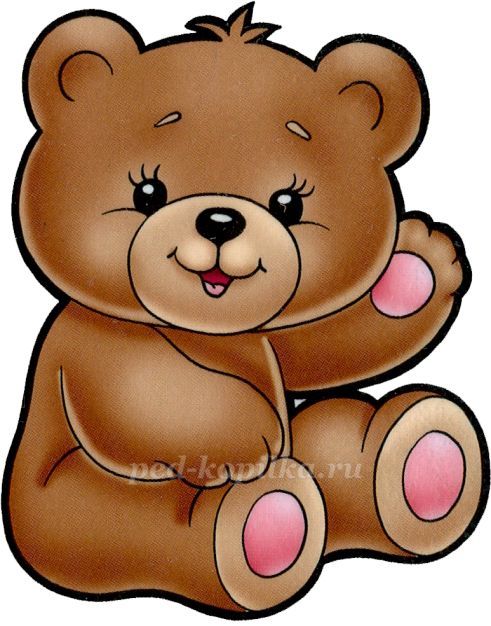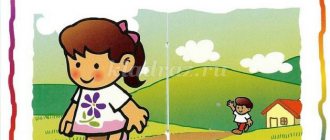Summary of a math lesson in the junior group “One, many, the same, more, less”
Summary of a lesson with children 3-4 years old on the topic “One, many, the same, more, less”
Author:
Alla Aleksandrovna Yakovleva
Description: this lesson summary will be useful for educators working with children 3-4 years old. Goal: to consolidate the concepts of “one”, “many”, “same”, “more”, “less”. Program content • Educational objectives:
– continue to teach how to determine the number of objects – one or many;
– continue to teach the comparison of equal and unequal sets through application; – exercise the ability to name primary colors: green, blue; – practice the ability to arrange objects with your right hand from left to right. • Developmental tasks:
– develop the ability to analyze, compare, generalize.
• Educational task:
– to develop the skills of polite greeting and farewell, to cultivate hospitality.
Vocabulary work: “many flashlights”, “one flashlight”; “multi-colored lanterns”, “blue lantern”, “green lantern”; “there are as many lanterns as teddy bears”; “one at a time”, “not a single one”; “there are more bear cubs than lanterns,” “there are fewer lanterns than bear cubs.” Aids Demonstration material (D):
paper bear, colorful box.
Handout (P):
a card with a picture of three teddy bears, one blue or green lantern, a tray with four small lantern figures.
Progress of the lesson
Children sit in a semicircle.
There's a knock on the door. A bear comes to visit. Educator: Guys, look who came to us?
Children: Bear. Educator: Let's say hello to Mishka. Children: Hello, Mishka! Bear: Hello, guys! I am very glad to see you! Educator: And we are glad to see you, Mishka. Yes, you didn’t come to us empty-handed! Guys, Mishka brought a box. Bear, is this for us? Bear: Yes. These are my gifts to you. Educator: How attentive you are, Mishka! Can I see what's in your beautiful box? Guys, let's see what Mishka brought us? (Opens the box and takes out the flashlights.)
Guys, tell me, what is this?

Children: Flashlights. Mishka brought us lanterns. Educator: How many lanterns did Mishka bring us? Children: A lot. Educator: That's right, Mishka brought us a lot of lanterns. Nastya, tell me, how many lanterns did Mishka bring? Nastya: Lots of flashlights. Educator: How many bears came to us? Children: One. Educator: One bear brought us a lot of lanterns. And they are all different colors. You could say: multi-colored lanterns. Let's all say it together: colorful lanterns. Children: Multi-colored lanterns. Educator: Bear, thank you for such beautiful colorful lanterns! Children, take one flashlight each. (All children take one flashlight from the box. The teacher asks each child how many flashlights he takes.)
Let each of you look carefully at your flashlight and think what color it is.
And Mishka will ask who has what color flashlight. Bear: Nastya, how many flashlights do you have? Nastya: Alone. Bear: Seryozha, what color is your flashlight? Seryozha: Green. Bear: Who else has green flashlights? Raise the green lanterns. (Children raise green lanterns.)
How beautifully they burn!
Lower the green lights. Sasha, what color is your flashlight? Sasha: I have a blue flashlight. Bear: Who else has a blue flashlight? Raise the blue lanterns. (Children raise blue lanterns.) Educator: It turns out that Mishka brought us green and blue lanterns. And now he wants to play the game “Colorful Lanterns” with you. When I say: “The blue lanterns are lit,” those guys who have a blue lantern need to get up and walk around the room with it, “illuminate” it. And when I say: “The green lanterns are lit,” those guys who have a green lantern need to do the same. So, evening came, the room became dark - it was time to turn on the lanterns. The blue lanterns came on. (Children with blue lanterns walk around the room, “illuminating” it.)
Well done, how attentive you are: only blue lanterns “light up”!
The green lanterns came on. (The children stand up with green lanterns, and everyone walks around the room.)
The room has become very light, because both blue and green lanterns are burning.
But then morning came. First the blue lights went out. Have everyone with a blue flashlight squat down. (Children with blue lanterns squat down.)
Then the green lanterns went out.
(Children with green lanterns squat down.)
Guys, how many lanterns have gone out?
Children: A lot. Educator: Did you like the game? Thank you, Mishka, for the interesting entertainment! Children, how many flashlights do each of you have? Children: One at a time. Educator: How many flashlights are in the box? Children: None. Educator: Now put your flashlights in the box. (Children put lanterns in a box. The teacher asks each child how many lanterns he put in, what color.)
How many lanterns are there in the box?
Children: A lot. Educator: Everyone put one flashlight, and there were a lot in the box. Nastya, how many flashlights are there in the box? Nastya: A lot. Educator: Oh! Mishka tells me that he is in trouble. He lost his cubs because the forest is dark and the little bear cubs cannot find their way home. Guys, let's help the bear cubs? Shall we give lanterns to illuminate the road? Children: Yes, we will help. Educator: I prepared small lanterns, because the cubs are still babies. Let's go into the forest for Mishka. He will show us the way so that we do not get lost. (Children follow the teacher to the tables, following his instructions, performing various movements: “raising our legs high, stepping over bumps,” “jumping over a stream,” etc.)
Here we are in the forest. Look around carefully and find the lost cubs. Who did you find?

Children: We found cubs! Educator: How many cubs did you find? Children: A lot. Educator: Now I will give you flashlights. (Each child is given a tray with four lantern figures.)
Let's give each bear one lantern so that they all return home safely.
Guys, you need to take the flashlights with your right hand and lay them out from left to right. Raise all your right hands. (Children raise their right hand.)
In total, you need to take as many lanterns as the cubs.
Be careful: there may be extra flashlights left. (Children place lanterns next to the images of bear cubs.)
Guys, how many lanterns did you take?
Children: We took so many lanterns, so many bear cubs. Educator: Vitya, how many flashlights did you take? Vitya: I took as many flashlights as the cubs. Educator: What can you say about the number of lanterns and teddy bears? Children: There are as many bear cubs as there are lanterns; there are equal numbers of them. Educator: It turns out that another bear cub was found. (Places another bear cub on each child’s card.)
Guys, look who or what has become more numerous: bear cubs or lanterns?
Children: There are more bear cubs than lanterns. Educator: Who or what has become smaller: bear cubs or lanterns? Children: There are fewer lanterns than teddy bears. Educator: What do you think needs to be done so that there are equal numbers of teddy bears and lanterns? Children: Give this little bear one flashlight. Educator: Make sure that there are equal numbers of lanterns and bear cubs. (Children complete the task)
.
Lena, what did you do? Lena: I gave one flashlight to the bear cub. Educator: What can you now say about the number of teddy bears and lanterns? Children: There are as many bear cubs as there are lanterns. There are as many lanterns as there are cubs. There are the same number of teddy bears and lanterns. Educator: Bear says thank you. With flashlights, the cubs will easily find their home, and we will return to kindergarten. Let's say to Mishka and the cubs: “Goodbye!
Come to our kindergarten, we will always be glad to see you .
(Children repeat this phrase. Then everyone “returns” the same way, performing the same movements.)
Here we are in kindergarten.
Children, did you like it in the forest? What did you like most? Children: Help the cubs, give them lanterns. Educator: Did you like how Mishka and I played the game “Colorful Lanterns”? We gave the little bear cubs small lanterns, and Mishka gave us large lanterns. We are already big! We know how to play together. We know colors and know how to “light” either green or blue lanterns. We can compare the number of cubs and lanterns. Thanks to your skills, today none of the cubs were left without a flashlight. And we will take the lanterns that Mishka gave us for a walk and play different games with them.
We recommend watching:
Summary of GCD in mathematics in the younger group. The use of non-traditional forms of work in mathematics GCD for children of the junior group in mathematics “Bigger, smaller, smallest” Summary of a lesson in mathematics 2nd junior group “Geometric figures” Summary of a lesson on FEMP in the 2nd junior group. Journey to Geometry
Similar articles:
Summary of a mathematical game in the second junior group
Summary of the game in mathematics in the younger group
Mathematics lesson in the younger group “Parts of the day”
Summary of the lesson in mathematics “Number and figure 2”. Junior group
Summary of a mathematics lesson in the junior group “Coding geometric shapes”
Preview:
Didactic game “ONE - MANY”
Purpose of the game: teaching children to correctly form singular and plural nouns in speech; Equipment: ball, object pictures; Progress of the game: the adult names a noun in the singular and throws a ball to the child, the child must throw the ball back, while naming the plural. It is advisable to play the game in the form of riddles using clear, colorful pictures. So that you can understand me, you will have to guess the riddles. Each word has its own meaning, which is indicated by the purpose of the words.
Light, airy, obedient to the wind. When inflated, it flies, and when deflated, it rests. If you hit it hard, it may burst immediately. (Ball) (show pictures to children) -Ball one
The old one is small, and the new one is big.
Sometimes it is simple, sometimes it is colorful. He will help me write in a notebook, color, draw a picture. He will be with me in class, My Friend. And he is my assistant in my studies. (Pencil) -Pencil one
It ripens on a tree in the garden. The taste and color of the fruit varies. Both sour and sweet - It tastes pleasant. Green, yellow, red, it’s useful! Everyone knows about it. (Apple) -One apple
A multi-colored bun, He will give you a hand, He is not afraid of pain, He loves to jump and roll! Who is jumping around so cheerfully? - My cheerful, round one. (Ball) -Ball one
Appeared at the neighbor's - Good hen, Bright fluffy radiant suns. Nice guys Yellow. (Chickens) -One chicken, many chickens
Without a command they get into formation and go to the pond. Who walks in a long chain, Who loves discipline so much? (Ducklings) -One duck, many ducklings
White fluffs are flying, circling in the wind. Cold beauties covered the whole earth with blankets in the morning. There are countless patterns. Snow-white fluffs - These are delicate. (Snowflakes) - Snowflake alone
She'll dress up in winter With garlands and balloons, Hidden gifts She's for the kids It's not in vain that it's sung in the song That was born in the forest, But I'll buy one made of plastic - I'll save the beauty! (Christmas tree) -One Christmas tree, many toys
Consolidating the studied material for the development of attention, memory, thinking, speech: - There is one ball, but there are many. (balls) ; -One pencil, but many. (pencils); -One apple, but many. (apples) ; - There is one ball, but there are many. (balls) ; - There is one chicken, but there are many. (chickens) ; - There is one duck, but there are many. (ducklings) ; - There is one snowflake, but there are many. (snowflakes); - There is one Christmas tree, but there are many. (toys); Thus, the use of didactic exercises in the learning process develops children's imagination, memory, and helps to activate accumulated information and vocabulary.
Source
Interactive didactic game “One - Many”
Anna Kostyleva
Interactive didactic game “One - Many”
Age group: 3-4 years
The purpose of this manual is to develop children’s ability to denote aggregates with the words “one”, “many”.
Tasks:
1. Develop the ability to answer the question “How much?”; fix the names of pets.
2. Develop attention, perception, memory.
3. Cultivate cognitive interest.
The manual contains 14 slides.
Description of working with slides
1. The teacher offers to play a game using the “magic screen”.
How many cows? One cow By clicking LMB (left mouse button) a picture appears - a cow
How many cows? Many cows by clicking LMB (left mouse button) a picture appears - several cows
3. What is a baby cow called? Calf
How many calves? One calf By clicking LMB (left mouse button) a picture appears - a calf
How many calves? Many calves by clicking LMB (left mouse button) a picture appears - several calves
How many horses? One horse By clicking LMB (left mouse button) a picture appears - a horse
How many horses? Many horses by clicking LMB (left mouse button) a picture appears - several horses
5. What is a baby horse called? Foal
How many foals? One foal By clicking LMB (left mouse button) a picture appears - a foal
How many foals? Many foals, by clicking LMB (left mouse button), a picture appears - with foals
How many ducks? One duck By clicking LMB (left mouse button) a picture appears - a duck
Game simulator “One-many”
Elena Sorokina
Game simulator “One-many”
“ One-Many training game is designed for children 2-3 years old. The game is simple , by clicking the mouse the slides change. On each slide, the child is greeted by two characters: a bunny and a baby elephant. An adult can start a dialogue with a child or group of children. Children can happily communicate with their parents while consolidating their memory, developing speech communication, and attention. Parents can show their imagination during the game, read poems about a bunny, a baby elephant by A. Barto. While playing, you can use multiple meanings, consolidate the general concepts of “shoes”, “toys”, learn to speak for a bunny, a baby elephant by changing intonation. All this together causes an active emotional response in children 2-3 years old, provoking childhood maturation. Play with your children , enjoy the moments of communication that you spend. When your kids grow up, you will remember the time you spent earlier with great pleasure. Thank you, if anyone liked it, I will be glad. This is my first experience in creating such games.
Attached files:
“One, many, none” Formation of elementary mathematical concepts second junior group Educational area: “Cognition” Section: Formation of elementary mathematical concepts. Topic: one, many, none Purpose: to form.



